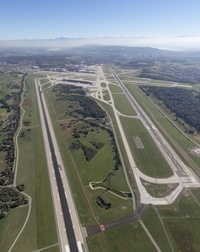Den Luftverkehr umweltfreundlicher machen
Leisere und klimafreundlichere Anflüge – dank intelligenter Assistenz
Der Landeanflug von Passagierjets ist für Menschen und Umwelt oft eine Belastung. Das «DYNCAT»-Projekt, in dem Empa-Forschende mit weiteren Partnern in der Schweiz, Deutschland und Frankreich zusammenarbeiten, schafft die Grundlagen für Anflüge, die weniger Lärm und CO2-Emissionen verursachen – dank intelligenter Hilfssysteme für die Piloten.
Der Anflug zur Landepiste eines Flughafens ist für Pilotinnen und Piloten eine echte Herausforderung: Reduzierung der Geschwindigkeit, Ausfahren von Landeklappen sowie Klappen auf den Flügeln, «Speed Brakes» genannt, und vieles mehr – und das alles mit möglichst wenig Lärm und geringem Treibstoffverbrauch. Noch dazu schränkt die Flugsicherung das Anflugprofil ein, und die Wetterbedingungen sind zuweilen nur vage bekannt. Kurzum: Neben Wind und weiteren Faktoren entscheiden die Fähigkeiten des Flugpersonals heute wesentlich darüber, wie gut ein Anflug all diesen Ansprüchen genügt.
Um diesen Prozess zu optimieren, zielt das «DYNCAT»-Projekt unter Federführung des Deutschen Zentrums für Luft- und Raumfahrt (DLR) darauf ab, umweltfreundliche und einheitlichere Flugprofile zu ermöglichen. Insbesondere im Anflug, indem es die Piloten bei der effizienten Konfiguration des Flugzeugs unterstützt – und auch beim Energiemanagement: Dabei werden die potenzielle und kinetische Energie des Jets durch den Luftwiderstand abgebaut, der wiederum durch die Konfiguration des Flugzeugs anpassbar ist. Im Idealfall bedeutet das: ein Anflug ohne Erhöhung des Schubs, der dem Flugzeug zusätzliche Energie zuführt und mehr Lärm erzeugen würde.
Neuartige Assistenz-Funktionen
Im Rahmen des Projekts entwickelten die beteiligten Fachleute neue On-Board-Systemfunktionen, die Pilotinnen und Piloten während des Anflugs unterstützen – mit Empfehlungen, über deren Umsetzung die Piloten dann selbst entscheiden. Dazu gehört unter anderem die optimierte Einstellung von Klappen und Fahrwerken, um Lärm und Treibstoffverbrauch zu reduzieren – fein abgestimmt auf das komplexe Zusammenspiel aller Faktoren und Anforderungen. Um die Fähigkeiten dieser Systemfunktionen zu demonstrieren, Lärm- und CO2-Emissionen zu mindern, wurden Simulatorflüge mit erfahrenen Piloten beim Luftfahrtkonzern Thales in Toulouse durchgeführt.
Das Anflugziel: Flughafen Zürich, Piste 14. In der gewählten Situation wies der Fluglotse die Piloten an, während des Sinkflugs eine seitliche Abkürzung zu nehmen, die das Flugzeug in einen sogenannten «Überenergie-Zustand» führt. Das bedeutet, dass es eine zu hohe potentielle und kinetische Energie hat, die während des Anflugs bis zur Landung abgebaut werden müssen – doch ohne unnötigen Lärm zu erzeugen und mehr Treibstoff zu verbrauchen. Eine besonders schwierige Situation für Pilotinnen und Piloten, bei der verschiedene Strategien möglich sind.
Vorteile im Film sichtbar gemacht
Wie sich das Assistenz-System auswirkt, haben die Forschenden von der Empa-Abteilung «Akustik / Lärmminderung» in einem Video (siehe unten) veranschaulicht: Es zeigt die Lärmbelastung durch zwei Beispielflüge – einer mit Nutzung der «DYNCAT»-Funktionen und ein Referenzflug ohne diese Hilfe. Das Fluglärmmodell «sonAIR», das an der Empa entwickelt wurde, berechnete die Schalleinwirkung der beiden Varianten am Boden – und quantifizierte so die Vorteile des neuen Systems.
Allgemein zeigten die Simulationen und Berechnungen, dass Anflüge mit dem Einsatz von «DYNCAT» meist leiser verlaufen und weniger Treibstoff verbrauchen. Im Fall der beiden Varianten im Video verbrauchte der Flug vom Beginn des Sinkfluges an 55 Kilogramm weniger Treibstoff und war bis zu 4 Dezibel leiser – eine spürbare Entlastung. Trotz hoher Anforderungen an klimafreundliches sowie lärmarmes Fliegen, die sich teils widersprechen, gelang es dank «DYNCAT» also, beide Ziele besser zu erreichen.
Simulationen und Analysen: Resultate des Forschungsprojektes im Video (englisch)
Zum Projekt
«DYNCAT» (kurz für: DYNamic Configuration Adjustment in the Terminal Manoeuvring Area) ist ein Kooperationsprojekt mit Partnern am Deutschen Zentrum für Luft- und Raumfahrt (DLR), Standort Braunschweig, dem französischen THALES-Konzern, der «Swiss SkyLab Foundation», den Swiss International Air Lines und der Empa. Das Projekt wird durch das gemeinsame Unternehmen SESAR im Rahmen des Forschungs- und Innovationsprogramms Horizon 2020 der EU finanziert. «DYNCAT» startete Mitte 2020 und wird bis Ende 2022 laufen.
Jonas Meister
Abteilung Akustik / Lärmminderung
Tel. +41 58 765 42 46
Dr. Jean-Marc Wunderli
Abteilungsleiter Akustik / Lärmminderung
Tel. +41 58 765 47 48







